E-Commerce Conversion Rate Optimization: 10 Tips to Boost Your Sales in 2025
Wondering how you can improve your online store’s conversion rate?
This article will cover ten actionable tips for increasing your e-commerce site’s conversion rate.
TL;DR
- E-commerce conversion rate optimization increases the percentage of customers on your website that convert.
- Instead of focusing on new client acquisition, you can optimize your conversion rate to maximize the revenue you get per visitor.
- Some of the best ways to increase your store’s conversion rate are to set up an AI assistant on your store to help shoppers, add personalized product recommendations, and optimize your product pages.
What is E-Commerce Conversion Rate Optimization & Why It’s Important?
E-commerce conversion rate optimization is the process of increasing the % of shoppers on your website that converts.
Improving your online store’s conversion rate is mostly done by improving the customer experience by:
- Enhancing personalization (e.g., better product recommendations).
- A/B testing landing pages and product copy.
- Making it easy to purchase.
- Answer all of your customer's questions before they can make an informed decision.
Instead of constantly focusing on new client acquisition, optimizing your conversion rate means that you can maximize the sales you make from your existing users.
10 Ways to Boost The Conversion Rate of Your Online Store
According to CRO statistics, only 22% of companies are happy with their conversion rates.
We will discuss ten actionable ideas for improving your site’s conversion rate, including case studies, software used, and best practices.
#1: Set Up a Conversational Experience in Your Store To Assist Shoppers
You can set up a conversational experience in your online store to assist your shoppers in choosing the right product for their needs.
Your customers could ask the AI-powered assistant contextual questions about your products from anywhere on your site.
A tool like Big Sur AI (that’s us) can achieve such AI-powered conversion rate optimization.
Big Sur AI’s Sales Agent can understand user intent and converse with your shoppers as a human would, 24/7.
Here’s an example from Rad Power Bikes when asking the AI assistant to compare two different e-bikes ⤵️
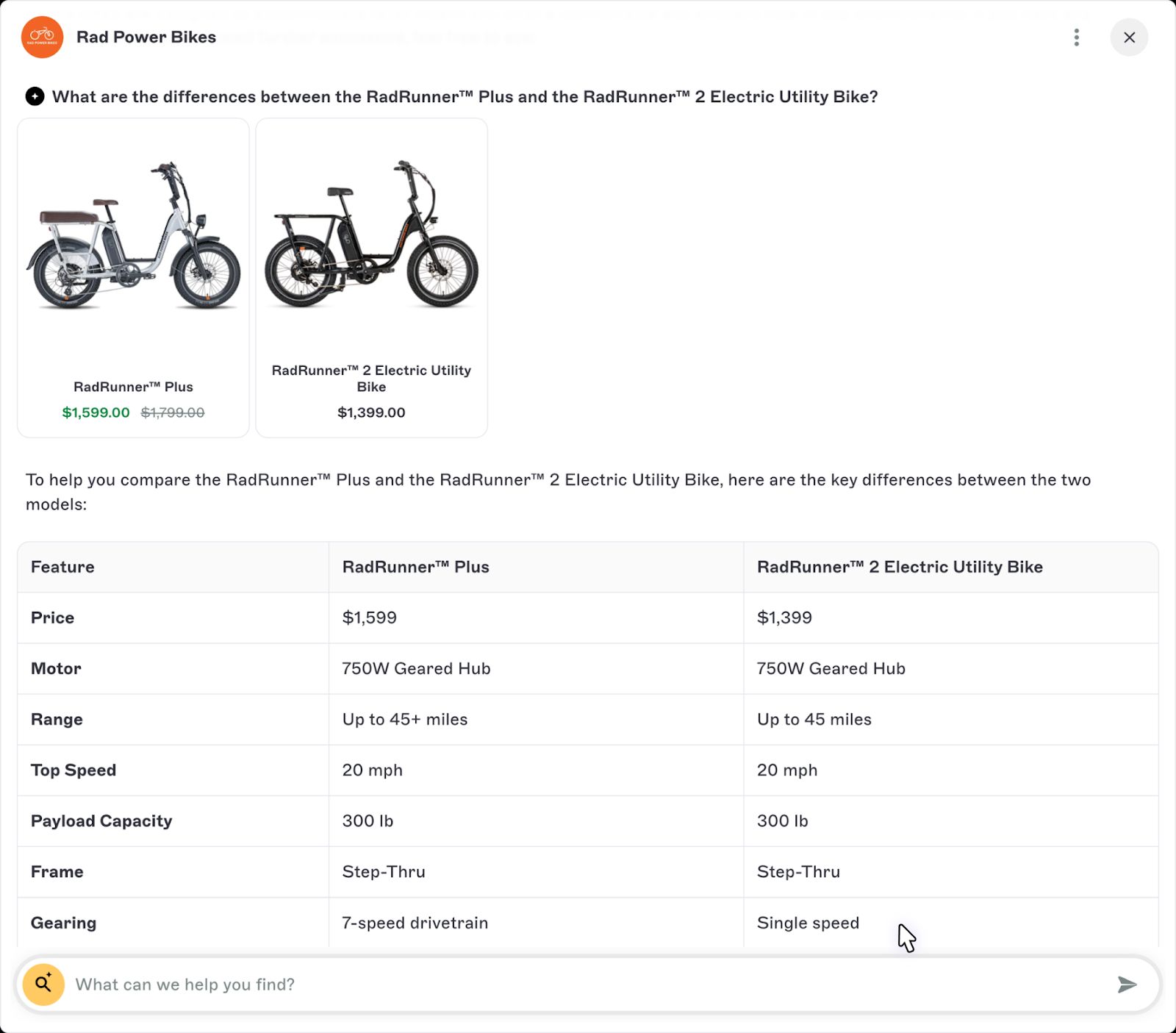
The AI Sales Agent is trained to provide personalized answers based on the information about your products, site content, and each shopper’s engagement with your store.
The software's advice has been optimized for conversions, providing relevant recommendations.
The sales agent then proposes follow-up questions based on data-driven predictions of what would likely lead to a conversion.
Here’s the AI Sales Agent in action ⤵️:
You can set up a chat-based assistant like Big Sur AI to provide 24/7 real-time support to prospective customers to recreate the in-store shopping assistant experience.
The results? Rad Power Bikes sees a 12% conversion rate of shoppers who converse with the AI Sales Agent.
This is a 4x increase compared to their a
verage conversion rate in their store.

Your brand will also get insights into the conversion rates of each question your users ask that leads to a conversion.
This will help your marketing team identify the crucial pre-purchase questions interested shoppers ask.

#2: Add Personalized Product Recommendations
You can increase your online store’s conversion rate by personalizing the customer experience with product recommendations.
Personalized product recommendations are tailored suggestions made to customers that are based on their:
- Unique product preferences.
- Browsing history.
- Purchasing behavior.
The recommendation engines use machine learning (ML) to offer products most likely to appeal to each customer.
This recommendation engine is real-time and personalized to each visitor, ensuring that your users see the most up-to-date products based on their last interaction.
💡Statistics show that customized recommendations can make 28% of shoppers more likely to buy a product they didn’t intend to purchase initially.
Product recommendation software like Big Sur AI makes contextual product recommendations based on:
- Shoppers’ engagement with your store, such as transactional history.
- Information that was gathered through the conversational experience with the AI assistant.
Big Sur AI's product recommendations are broken into three modules:
- Picked just for you: Products that a shopper will most likely buy based on what the tool knows about them.
- Frequently bought together: These recommendations appear once shoppers add a product to their cart. This module features other products that customers buy based on their previous activity.
- Top sellers: The bestsellers in the same product category as the product your shoppers are considering.
The software shows items based on the customers' gathered information and not generic recommendations.
Here’s what the product recommendations look like on the Wyze store ⤵️
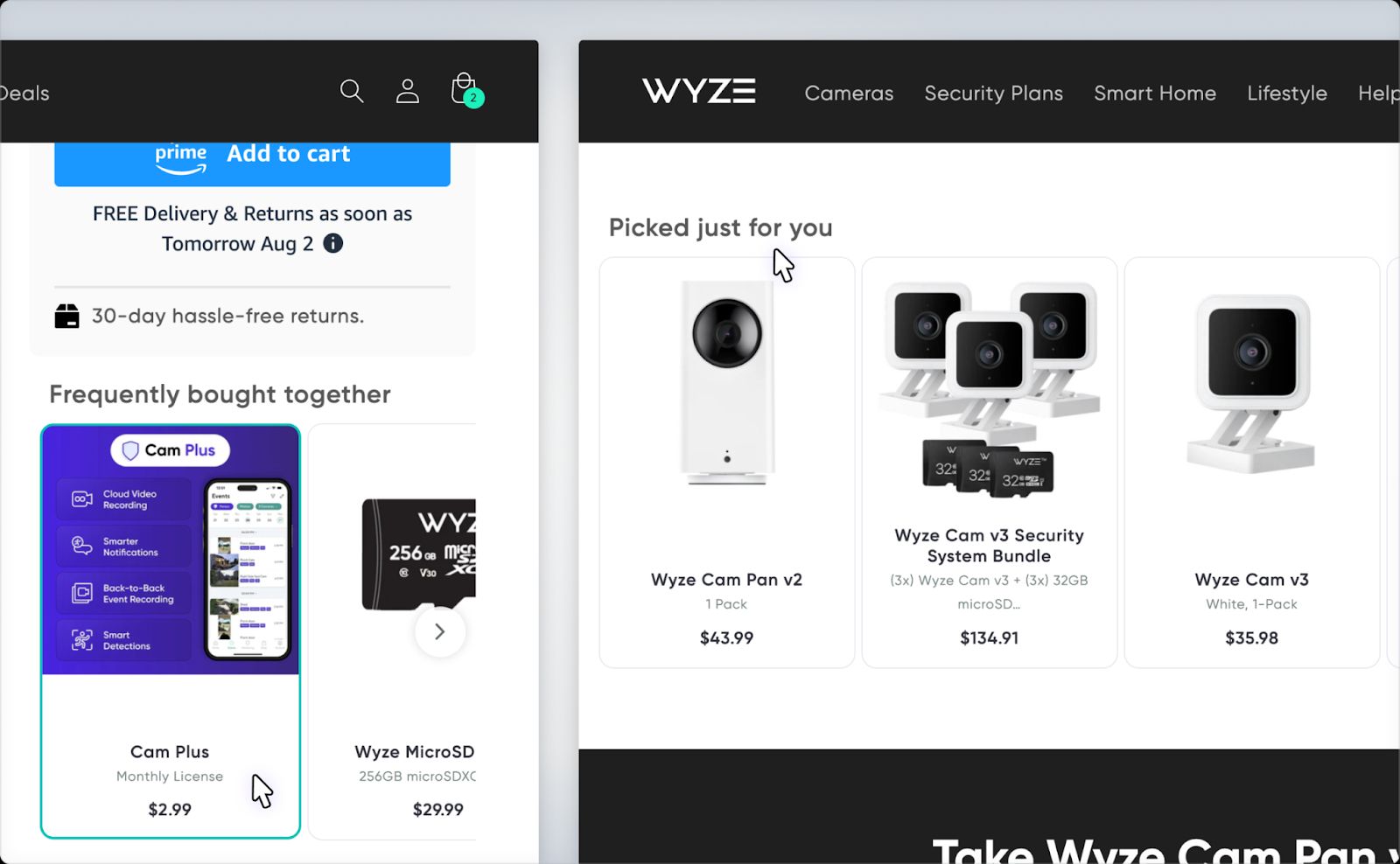
Your customers can receive these product suggestions on your product pages or during a conversation with the AI Sales Agent, increasing your conversion rate.
#3: Craft Automated Email & SMS Campaigns
You can increase your conversion rate through automated email and SMS campaigns.
Automate your customers' experience with:
- Abandoned cart reminders: Nudge your customers to return to their cart and complete the purchase.
- Win-back campaigns: Encourage your customers to re-engage with your brand.
- Personalized discount codes: From birthday discounts to customized product offers.
- Product recommendations: AI-powered predictive analytics and machine learning (ML) algorithms recommend products to individual shopper preferences.
Retailers like 100% Pure utilize e-commerce marketing tools like Klaviyo to build automated email campaigns.
The DTC beauty retailer created abandoned cart flows triggered by Shopify activity and other automatic flows, such as nurturing campaigns.

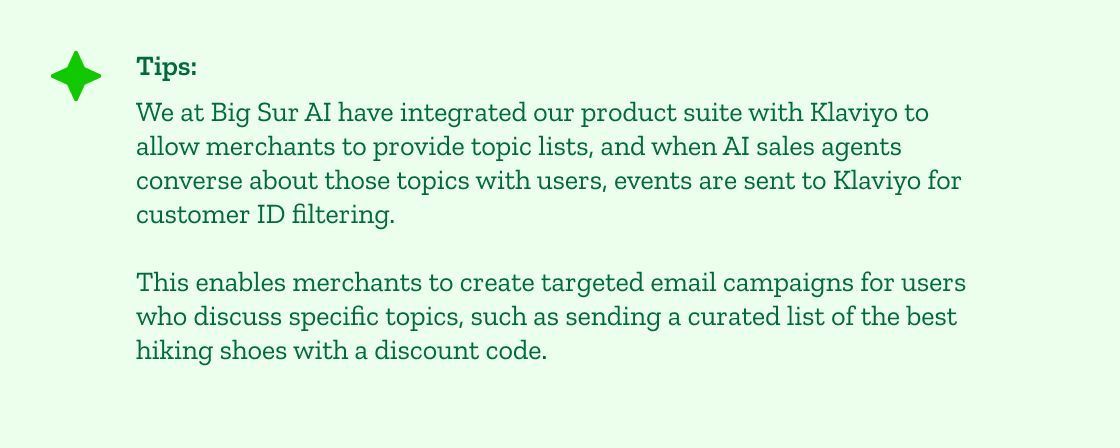
Other brands, like Sonos, used "Back-in-Stock" personalized emails to inform their shoppers when an item was back in stock.
The tool considered which pages customers browsed and then segmented them automatically to improve their open and conversion rates.
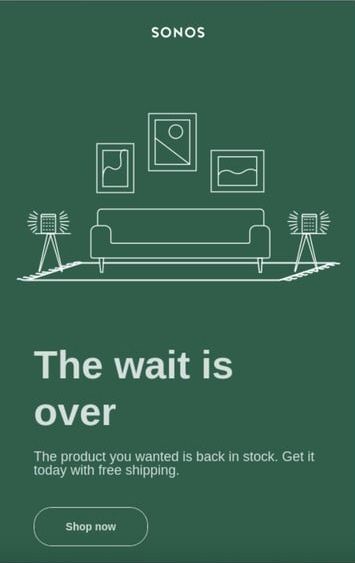
#4: Set Up a Semantic Site Search
You can improve your online store’s conversion rate by setting up an AI-powered semantic site search on your website.
As a relevant search result influences 39% of consumers, your brand can delight your shoppers with a site search functionality that shows them what they want.
Online brands are setting up an AI site search that can understand the user intent of the search queries instead of only matching keywords to products.
When your shoppers are searching on your site search, the search engine recommends them products based on their shopping journey and purchase behavior.
The goal is to minimize the ''null'' results shoppers get when no product is matched and optimize for non-product queries (e.g., searching for the return policy).
💡The personalization technology works similarly to how product recommendations work.
The semantic search combines the search query with shopper data (e.g., pages browsed) to return an accurate response.
For example, Level Nine Sports improved its conversion rate by 23.39% by utilizing a personalized site search.

The brand transformed its product discovery experience for its shoppers, enabling AI-driven optimization for specific product searches and synonym recognition.
This implementation also enhanced inventory utilization by promoting niche items, allowing the company to clear out old stock.
Tools like Bloomreach combine first-party shopper data alongside predictive analytics to suggest relevant product recommendations in its semantic search.
#5: Make it Easy to Purchase
You can optimize your site’s conversion stage from the e-commerce conversion funnel by making it easy to purchase your products.
➡️ It sounds like an easy step to take and something your brand must excel at now, but many merchants get this wrong.
Your brand must make buying easy after prospective customers are ready and feel like they’re making an informed decision.
A common reason why customers did not convert even though they thought they were ready was because the purchasing process was too slow.
For example, filling out all the details took too long, and they had to shift through 3-4 pages before ordering their product.
Brands like Allbirds offer a single-page payment process that lets you:
- Express checkout with PayPal, Apple Pay, Amazon Pay, and Shop Pay.
- Fill out your shipping information and payment method quickly.
- Insert a discount code.
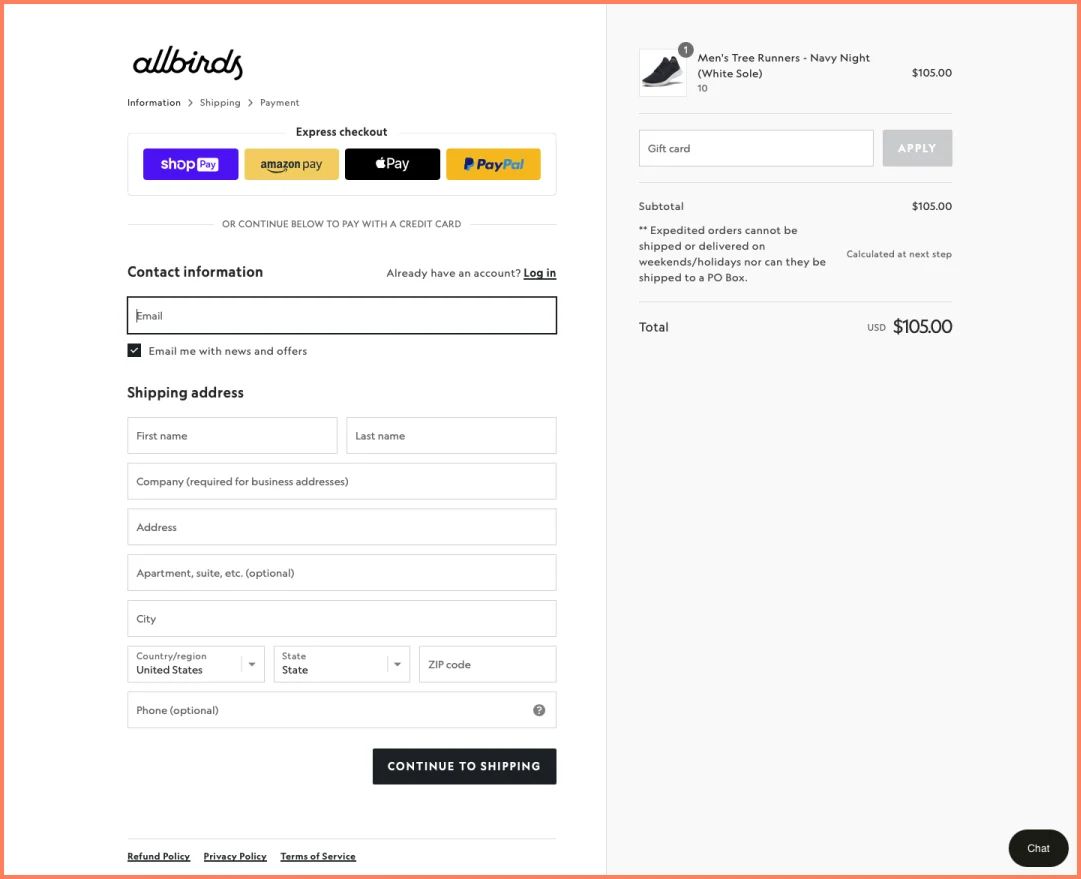
Notice how the brand did not expect you to have an existing account to complete the purchase.
Shoppers can place their orders anonymously without spending time creating an account.
#6: Offer Fast Shipping & Easy Returns
Another underrated trick to improve your conversion rate is offering fast shipping and easy returns.
Your customers need to know what to expect from your site when they are ready to buy.
This is why it makes sense to add:
- Delivery information and how long it will take to receive their products (the faster, the better).
- Returns information, such as policy and how easy it is to return products if they do not like them.
- The warranty and/or guarantee of the product and its quality. Customers wouldn’t want to take too much of a risk.
💡 Did you know that 84% of shoppers check the returns policy page before purchasing?
For example, as Amazon offers same-day delivery, consumers have become aware (and a bit entitled) of the value of quick delivery.
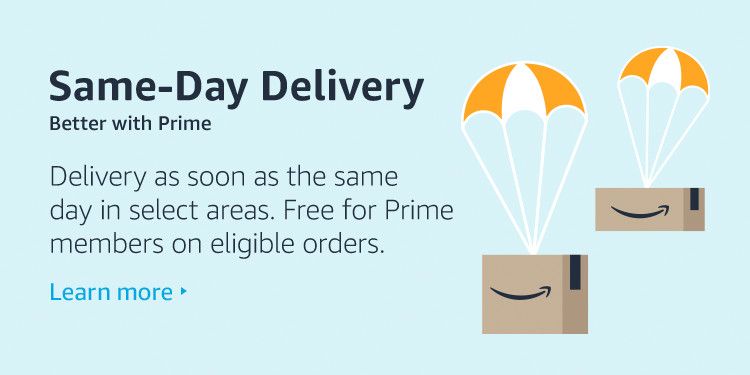
And if your customers need to return a product, your brand needs to make it as easy as possible for them to do it.
This would let you leave a good impression on them and increase the likelihood of recommending your brand to a friend or purchasing something else.
You can set up a returns platform like ZigZag Global or Aftership to make your returns process easier and track returns.

For example, ZigZag Global lets you save the sale by giving your customers the option to:
- Get an exchange other than a refund.
- Return to gift card so your customers can give a gift card to a friend who might benefit from your products.
- Refund to store credit so you can retail the revenue and let them choose another product.
#7: Set Up Smart Pop-Ups & Personalized Offers
Increase your e-commerce store’s conversion rate by setting up smart pop-ups and personalized offers.
These AI-powered tools use your shoppers’ interests and on-site behavior to show targeted pop-ups with customized offers.
There are different kinds of pop-ups, such as:
- On-page pop-ups that appear when your shoppers scroll down.
- Exit intent pop-ups that try to figure out when your shoppers are about to leave.
- Pop-ups that appear when your customers have been on the website for some time.
➡️ For example, ZooShoo increased its revenue by 7% with exit-intent pop-ups.
The US retailer discovered that many window shoppers browse their website without buying anything.
This is why they set up exit intent pop-ups offering a 10% discount on their women’s shoes.
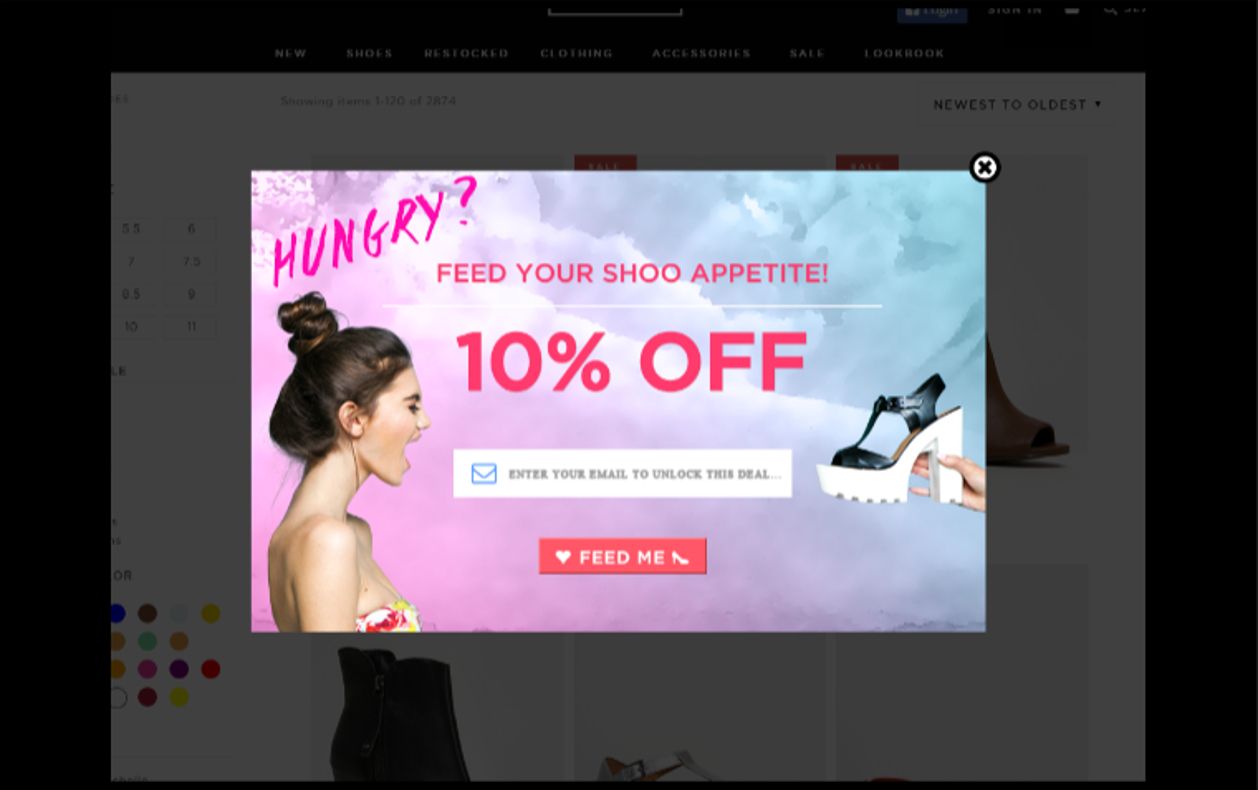
The brand achieved that with the conversion rate optimization tool OptiMonk, which lets you create conversion-optimized pop-ups, side-bars, and full-page overlays.
#8: A/B Test Your Product & Landing Pages
A/B testing is one of the top ways of improving your store’s conversion rate.
Merchants have been using A/B testing mechanisms incorporating shopper feedback to improve their stores continuously.
A/B testing is when you test 2 variables on your website and see which variable has a higher conversion rate.

For example, you can test:
- Page layout and design.
- Different product offerings.
- Product prices and discounts (dynamic pricing).
There is AI-powered A/B testing that figures out what has the biggest impact on your conversion rates and continues with the next test without you manually setting up each test.
➡️ For example, DeWalt used Optimizely to test different CTAs and navigation menus on their store to see which would increase the conversion rate.
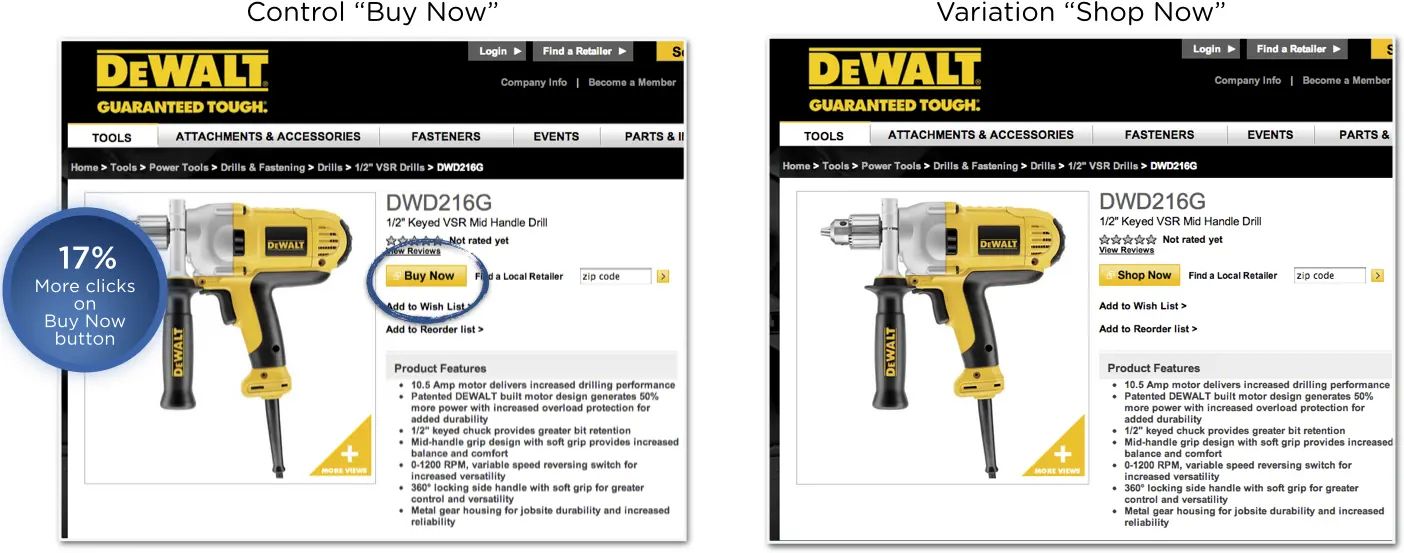
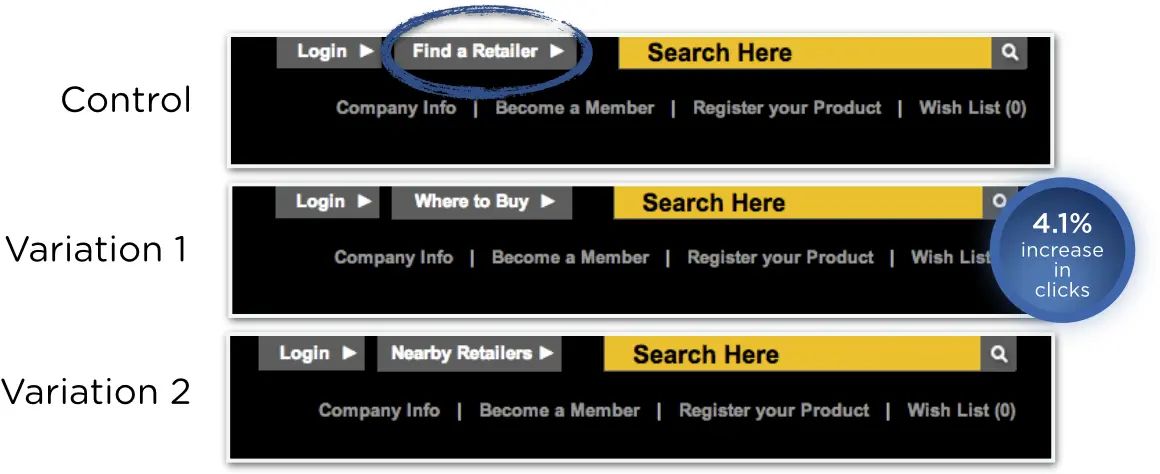
#9: Optimize Your Product Pages
Optimizing your product pages will help you convert more of your shoppers in the consideration stage in their buying journey.
Here are a few ideas of how you can optimize your product pages:
- Add more than just a description of the product: Improve your product descriptions with a video of how it is used, the materials used, what it is for, etc.
- Add reviews and testimonials of happy customers: You can add social proof, and also a comment section.
- Add delivery, warranty, and returns information: As discussed earlier, your shoppers need to know how much it will cost and when they can receive the products.
➡️ For example, Wyze has optimized its product pages with personalized questions tailored to each customer with Big Sur AI.
The tool analyzes how each consumer engages with their store.
Then, it predicts which questions they will likely ask and suggests them throughout their shopping experience.
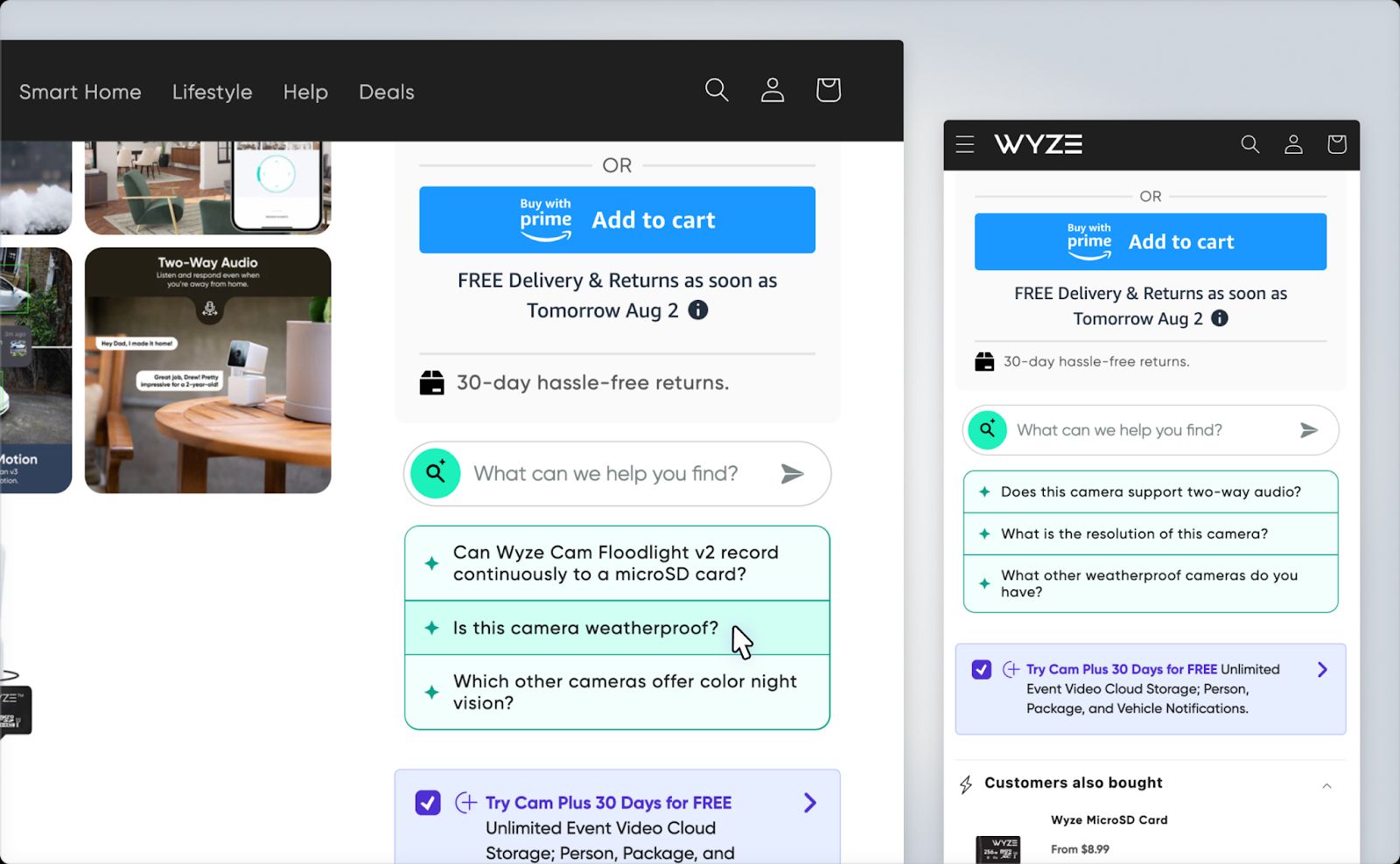
After the users click on the questions, they are taken to our AI assistant, powered by Generative AI, which answers their questions in-depth.
Instead of answering static questions that are commonly asked about the product, Big Sur AI enables merchants like you to provide personalized questions based on user intent.
The tool aims to alleviate customers' hesitations before purchasing by better educating them about your products.

These suggested questions are embedded on your product and category pages and are personalized for every customer on your website.
💡This means different shoppers would see different questions crafted to maximize the likelihood of purchasing.
#10: Offer Cross-Selling & Up-Selling
You can improve your store’s conversion rate and average order value (AOV) by setting up AI-powered cross-selling and up-selling on your store.
AI technology analyzes customer data to predict which products customers might be interested in or already in their basket.
After that, the tool generates sections in the product or category pages with recommended products.
➡️ For example, Wyze utilized Big Sur AI’s cross-selling feature to improve their conversion rate and average basket sizes.
They have set up ‘’Frequently Bought Together’’ on their product pages to analyze what products shoppers have added to their carts.

The brand also gained insights into what products are frequently bought together, which helped them improve their store’s shopping experience.

💡Cross-selling and up-selling do not have to occur only on your online store.
You can enable personalized email recommendations with tools like Klaviyo (based on website interactions), in-app suggestions, or targeted advertisements.
What Are The Best Conversion Rate Optimization Tools For E-Commerce?
Now that we've gone over some tips for improving your store’s conversion rate, you can check out our updated guide of the best CRO tools for retailers.
We cover each tool's use cases, pricing structure, and drawbacks.
Improve Your Conversion Rate With Big Sur AI
You can optimize your e-commerce store with a conversational experience that works 24/7 to assist your shoppers.
Our AI-powered Sales Agent can guide shoppers' product discovery journey with personalized recommendations and conversion-optimized prompts.
The conversational experience helps your shoppers find the right product for their needs.
Be data-driven about what products are frequently bought together and what pre-purchase questions customers have on your website.


